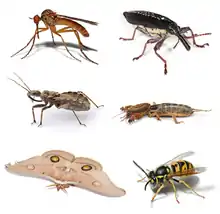Diaphanopterodea
The Diaphanopterodea or Paramegasecoptera are an extinct order of moderate to large-sized Palaeozoic insects. They are first known from the Middle Carboniferous (late Serpukhovian or early Bashkirian in age), and include some of the earliest known flying insects.
| Diaphanopterodea Temporal range: | |
|---|---|
| Scientific classification | |
| Domain: | Eukaryota |
| Kingdom: | Animalia |
| Phylum: | Arthropoda |
| Class: | Insecta |
| Superorder: | †Palaeodictyopteroidea |
| Order: | †Diaphanopterodea Handlirsch, 1919 |
| Families | |
| |
Overview
Despite their very early appearance in the insect fossil record, they represent a specialised group of Palaeodictyopteroidea (Palaeozoic beaked insects), unique among representatives of that group in having evolved the ability to fold their wings over their thorax and abdomen in a manner similar to, but not homologous with, the Neopteran insects. The nymphs also had an unusual appearance, being covered in numerous hairlike filaments.[1]
Diaphanopterodea are distinguished by a number of other characteristics, and are generally considered to be a monophyletic group. About ten families are known. The group died out at the end of the Permian period, victims of the End-Permian mass-extinction, without leaving any descendants.
References
- Hoell, H.V.; Doyen, J.T. & Purcell, A.H. (1998). Introduction to Insect Biology and Diversity (2nd ed.). Oxford University Press. p. 322. ISBN 0-19-510033-6.
- Carpenter, F. M. 1992. Superclass Hexapoda. Volume 3 of Part R, Arthropoda 4; Treatise on Invertebrate Paleontology, Boulder, Colorado, Geological Society of America.
- Grimaldi, David & Engel, Michael S. (2005-05-16). Evolution of the Insects. Cambridge University Press. ISBN 0-521-82149-5.
